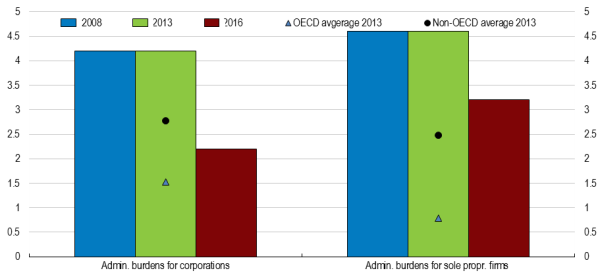G20: Toward an innovation-based economy 2020
Updated: 2016-09-06 14:46
By Margit Molnar(chinadaily.com.cn)
|
||||||||
Firming institutional capital as expected driver of entrepreneurship and innovation
Notwithstanding rapid productivity convergence and impressive build-up of infrastructure and knowledge over the past couple of decades, it has not been until very recently that the institutional environment is targeted to better suit the transition towards an entrepreneurial and innovative economy. A path-breaking achievement in this direction is the removal of barriers to entrepreneurship started during the current government. Since 2013, administrative procedures have been simplified and licencing requirements reduced. The OECD PMR indicators can capture these changes and show significant reduction of such burden both on corporations and sole proprietor firms (Figure 3). Benefiting from reduced barriers to set up businesses, the past year or so saw an unprecedented surge in new company registration, in particular in services.
Figure 3. Barriers to entrepreneurship are falling rapidly
Barriers to entrepreneurship component of the Product Market Regulatory indicator, 2013 and 2016
 |
|
The administrative burden on start-ups sub-component of the OECD Product Market Regulation indicator captures changes for corporations and sole proprietorships.[Source from OECD Product Market Regulation database.] |
Once a favourable environment is established for enterprise creation, it is also crucial to ensure that zombie companies do not take up resources and through efficient mechanisms exit the market. Such “creative destruction” is the driver of productivity growth by giving space to new ideas, new products and new processes.
- Xi tells Park China opposes deployment of THAAD in ROK
- Singapore confirms 27 new cases of Zika infection
- Russia, Britain agree to mend ties
- EU can't leave entire migration issue to mediterranean countries: official
- Rousseff appeals impeachment to Supreme Court
- Europeans displeased with their education systems

 First Ladies shopping in Hangzhou
First Ladies shopping in Hangzhou
 Flower children greet world leaders in Hangzhou
Flower children greet world leaders in Hangzhou
 World's largest transparent-domed bar under construction
World's largest transparent-domed bar under construction
 In pics: Journalists cover G20 Summit in Hangzhou
In pics: Journalists cover G20 Summit in Hangzhou
 Air attendant 'incubator' welcomes freshmen
Air attendant 'incubator' welcomes freshmen
 Evening gala for G20 summit held in Hangzhou
Evening gala for G20 summit held in Hangzhou
 First Lady fashion: Rhapsodies in blue
First Lady fashion: Rhapsodies in blue
 Hangzhou: A city of bridges in East China
Hangzhou: A city of bridges in East China
Most Viewed
Editor's Picks

|

|

|

|

|

|
Today's Top News
Trump outlines anti-terror plan, proposing extreme vetting for immigrants
Phelps puts spotlight on cupping
US launches airstrikes against IS targets in Libya's Sirte
Ministry slams US-Korean THAAD deployment
Two police officers shot at protest in Dallas
Abe's blame game reveals his policies failing to get results
Ending wildlife trafficking must be policy priority in Asia
Effects of supply-side reform take time to be seen
US Weekly

|

|







